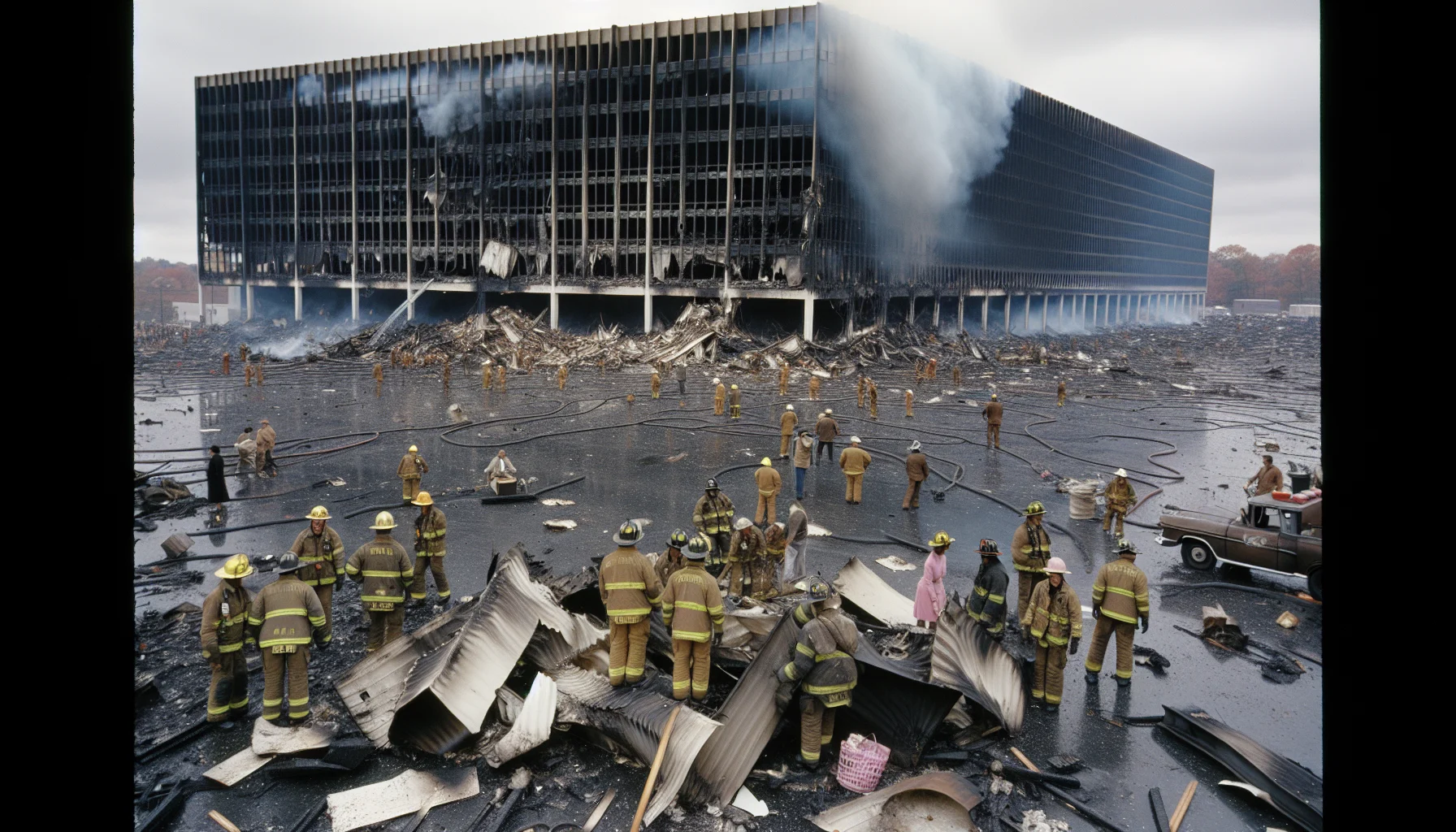
Sennichi Department Store Building Fire
by: The Calamity Calendar Team
May 13, 1972
A Morning in Osaka: The Sennichi Building
It was a typical busy morning in Osaka, Japan, on May 13, 1972. The Sennichi Building stood as a vibrant hub of commerce and entertainment in the bustling heart of the city. The multi-use structure housed the Sennichi Department Store, alongside cabarets and various entertainment venues, drawing locals and tourists alike. But as people flocked to its doors that day, the building, unbeknownst to them, concealed fatal flaws — a tinderbox ready to ignite.
A Complex with Hidden Dangers
The Sennichi Building was emblematic of post-war Japan’s economic surge — rapid growth, innovation, but also oversight. This maze of consumerism was held together by crowded shops and thin walls, a labyrinthine structure harboring hidden peril. The allure of this commercial complex masked the grim reality of its infrastructure: overcrowding, inadequate fire exits, and a patchwork of unregulated partitions. These features made the building a ticking time bomb, especially perilous in a setting reliant on electrically-driven signs and tightly packed patrons. These conditions were sadly familiar, as many urban structures across Japan’s cities bore similar vulnerabilities, remnants of a booming economy sometimes blind to safety.
Flames in the Cabaret: The Unfolding Disaster
The clock ticked towards 10:30 AM as workers toiled away on minor repairs inside one of the cabarets on the third floor. Sparks flew from a blowtorch — a routine task turned catastrophic ignition. In mere moments, the fire latched onto the highly flammable decorative materials adorning the cabaret's interior. It was as if the scene ignited in slow motion, yet the spread of flames was tragically swift.
The fire surged upwards, devouring the upper floors, with smoke snaking its way into every nook and cranny, rendering escape nearly impossible. Panic swept through the throng of trapped patrons, as staff and shoppers struggled to navigate their way through the acrid turmoil. The once-vibrant building became a chaotic tomb as sounds of fear and confusion mingled with the crackle of raging fire.
By the time emergency services arrived, the situation was dire. The fire had already woven its destructive path through much of the structure, and the design of the building — a boon for business but a bane for safety — hindered rescue efforts.
The Battle Against the Blaze
Rescue teams faced an uphill battle. The fire's chokehold on the building was only half the dilemma. Accessing the core of the blaze proved near impossible due to the convoluted layout. Emergency exits were few and far between, while the maze-like corridors misled many to dead ends disguised by smoke.
Thanks for subscribing!
Hours stretched agonizingly as firefighters waged a relentless battle against the inferno. The contrast between the heroic efforts of the rescue teams and the sheer scale of the disaster was palpable. It was as if the building itself conspired against their every move.
Finally, by mid-afternoon, the flames were under control, but the damage was extensive. Charred remnants told tales of shoppers and workers whose lives had been claimed by either flames or smoke. In total, 118 souls perished in the catastrophe, most lost to the suffocating grip of smoke inhalation. Heart-wrenching stories of loss began to surface amidst the debris, pulling the local and national community into deep mourning.
Aftermath: Reckoning with Tragedy
The inferno left not only a landscape of destruction but a haunting void in a community already burdened by grief. The charred skeletal remains of the Sennichi Building stood as an eerie backdrop to the tragedy’s human toll.
In the wake of such profound loss, those left behind were not content to quietly bury their dead; demands for change rang out across Japan. Public outcry reverberated through the halls of government, placing unyielding pressure on a system that had allowed such vulnerabilities to persist.
A Fire That Sparked Reform
From the ashes of the Sennichi fire emerged a movement for reform. The disaster illuminated glaring inadequacies in safety regulations, but it also served as a catalyst for transformation. Building and fire safety codes underwent rigorous revisions. New mandates emerged: fire alarms became compulsory, sprinkler systems sprung up in buildings nationwide, and emergency exits were no longer mere suggestions but essentials.
The fire also impacted international standards, acting as a cautionary tale to cities worldwide striving for balance in an increasingly urbanizing world. It served as a sobering lesson that economic progress must never outpace safety and humanity.
Legacy of the Sennichi Fire
Decades have unfolded since that harrowing day in May 1972. While the physical structure of the Sennichi Building is long gone, its story persists. It’s remembered not just for the lives lost, but for the change it galvanized and the lesson it etched into the fabric of urban safety standards.
Today, the memory of the Sennichi Department Store fire continues to guide discussions on public safety and building regulations. Each anniversary brings solemn reflection, but also a reaffirmation — a pledge to never forget the lessons learned and the preciousness of life woven through every exit, every alarm, and every regulation born from tragedy.
Stay in the Loop!
Become a Calamity Insider and get exclusive Calamity Calendar updates delivered straight to your inbox.
Thanks! You're now subscribed.